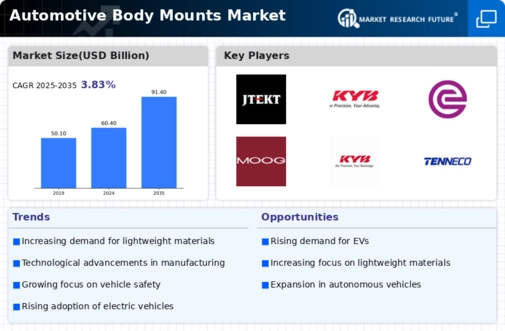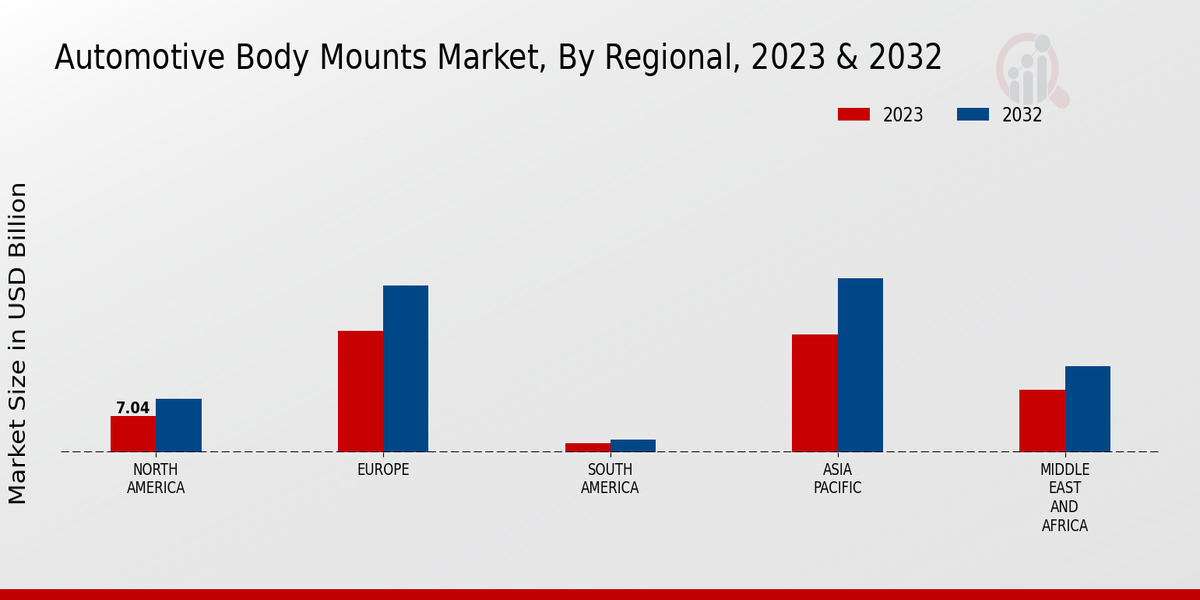Market Growth Projections
The Global Automotive Body Mounts Market Industry is on a growth trajectory, with projections indicating a market value of 60.4 USD Billion in 2024 and an expected rise to 91.4 USD Billion by 2035. This growth reflects a compound annual growth rate (CAGR) of 3.83% from 2025 to 2035. The increasing demand for automotive components, driven by factors such as vehicle production, technological advancements, and regulatory compliance, contributes to this positive outlook. The market's expansion is likely to be supported by innovations in materials and manufacturing processes, which enhance product performance and durability. As the industry evolves, these growth projections highlight the potential for investment and development within the automotive body mounts sector.
Rising Electric Vehicle Adoption
The Global Automotive Body Mounts Market Industry is witnessing a transformative shift with the rising adoption of electric vehicles (EVs). As automakers pivot towards sustainable transportation solutions, the demand for specialized body mounts that accommodate the unique design and weight distribution of EVs is increasing. This trend is fueled by government incentives and consumer interest in environmentally friendly vehicles. The integration of advanced materials and technologies in EV manufacturing necessitates innovative body mount solutions, further driving market growth. The anticipated increase in EV production is expected to contribute to the overall market expansion, aligning with projections of a market value of 91.4 USD Billion by 2035.
Increasing Vehicle Production and Sales
The Global Automotive Body Mounts Market Industry is significantly influenced by the rising production and sales of vehicles worldwide. As emerging economies continue to develop, the demand for automobiles is expected to surge, leading to increased production rates. This trend is particularly evident in regions such as Asia-Pacific, where automotive manufacturing is expanding rapidly. The growing consumer preference for personal vehicles, coupled with urbanization and rising disposable incomes, further fuels this demand. Consequently, the body mounts market is poised for growth, as these components are essential for vehicle assembly and performance. The anticipated market value of 60.4 USD Billion in 2024 underscores this upward trajectory.
Growing Demand for Lightweight Materials
The Global Automotive Body Mounts Market Industry experiences a notable shift towards lightweight materials, driven by the automotive sector's emphasis on fuel efficiency and emissions reduction. Manufacturers are increasingly adopting materials such as aluminum and advanced composites, which contribute to weight reduction without compromising structural integrity. This trend aligns with global regulatory pressures aimed at lowering carbon footprints. As a result, the market for body mounts is projected to grow, with estimates suggesting a market value of 60.4 USD Billion in 2024. The transition to lightweight materials is expected to enhance vehicle performance and fuel economy, thereby stimulating demand in the Global Automotive Body Mounts Market Industry.
Regulatory Compliance and Safety Standards
Regulatory compliance and safety standards are pivotal drivers in the Global Automotive Body Mounts Market Industry. Governments worldwide are implementing stringent regulations to enhance vehicle safety and environmental performance. These regulations necessitate the incorporation of advanced body mount technologies that ensure vehicle stability and occupant safety. Manufacturers are compelled to innovate and adapt their products to meet these evolving standards, which in turn drives market growth. The increasing focus on crash safety ratings and emissions standards is likely to propel demand for high-quality body mounts. As the market evolves, compliance with these regulations will remain a critical factor influencing the industry's dynamics.
Technological Advancements in Manufacturing Processes
Technological advancements play a crucial role in shaping the Global Automotive Body Mounts Market Industry. Innovations in manufacturing processes, such as 3D printing and automated assembly techniques, enhance production efficiency and reduce costs. These technologies enable manufacturers to produce complex designs with precision, catering to the evolving needs of automotive manufacturers. Moreover, the integration of smart technologies into body mounts, such as sensors for monitoring vehicle dynamics, is gaining traction. This evolution in manufacturing not only improves product quality but also supports the anticipated growth of the market, projected to reach 91.4 USD Billion by 2035, reflecting a robust CAGR of 3.83% from 2025 to 2035.
























Leave a Comment